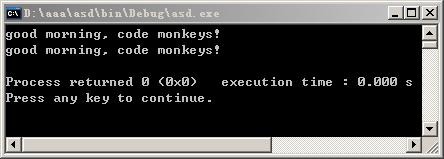问题(2)及代码:
/*
* Copyright (c) 2016,烟台大学计算机与控制工程学院
* All rights reserved.
* 文件名称:main.cpp
* 作 者:赵志君
* 完成日期:2016年4月28日
* 版 本 号:v1.0
*
* 问题描述:(1)阅读下面的程序,补足未完成的注释
*/
#include<iostream>
#include<cstring>
using namespace std;
class A
{
private:
char *a;
public:
A(char *aa)
{
a = new char[strlen(aa)+1]; //(a)这样处理的意义在于:为a分配空间,保证a指针指向的安全,同时保证a的长度的合理。
strcpy(a, aa); //(b)数据成员a与形式参数aa的关系:把aa指向的字符串首地址,传递给a。
}
~A()
{
delete []a; //(c)这样处理的意义在于: 释放掉为a分配的空间。
}
void output()
{
cout<<a<<endl;
}
};
int main(){
A a("good morning, code monkeys!");
a.output();
A b("good afternoon, codes!");
b.output();
return 0;
}问题(2)将注释(a)所在的那一行去掉,会出现什么现象?为什么?为什么a数据成员所占用的存储空间要在aa长度基础上加1?若指针a不是指向字符(即不作为字符串的地址),是否有必要加1?
答:去掉后则没有给a分配相应的空间,a的长度可能不足够储存aa所指向的字符串。
因为字符串后边会有一个结束符,而aa的长度只包含字符串的长度。
同样需要。
问题(3)及代码:
/*
* Copyright (c) 2016,烟台大学计算机与控制工程学院
* All rights reserved.
* 文件名称:main.cpp
* 作 者:赵志君
* 完成日期:2016年4月28日
* 版 本 号:v1.0
*
* 问题描述:(3)为类A增加复制构造函数,用下面的main函数测试
*/
#include<iostream>
#include<cstring>
using namespace std;
class A
{
private:
char *a;
public:
A(char *aa)
{
a = new char[strlen(aa)+1]; //(a)这样处理的意义在于:为a分配空间,保证a指针指向的安全,同时保证a的长度的合理。
strcpy(a, aa); //(b)数据成员a与形式参数aa的关系:把aa指向的字符串首地址,传递给a。
}
A(const A &t)
{
a = new char[strlen(t.a)+1];
strcpy(a,t.a);
}
~A()
{
delete []a; //(c)这样处理的意义在于: 释放掉为a分配的空间。
}
void output()
{
cout<<a<<endl;
}
};
int main()
{
A a("good morning, code monkeys!");
a.output();
A b(a);
b.output();
return 0;
}
运行结果:
学习心得:在写注释是,一些明白的东西却不能去用语言表达出来,应该需要把书上的概念记清楚。








 本文通过具体的C++代码示例介绍了类的实现方法,包括构造函数、析构函数及复制构造函数的作用与使用场景,并探讨了字符串在类中正确管理的重要性。
本文通过具体的C++代码示例介绍了类的实现方法,包括构造函数、析构函数及复制构造函数的作用与使用场景,并探讨了字符串在类中正确管理的重要性。

















 627
627

 被折叠的 条评论
为什么被折叠?
被折叠的 条评论
为什么被折叠?








